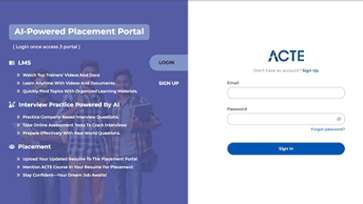A Selenium test automation framework and tool is used to automate tests administered on web browsers. This is most often used for testing shopping carts, email clients, and other web applications.Selenium testing is the process of testing using Selenium. There are a variety of tools within Selenium, and each one has a different way of testing.
Additional Info
Features of Selenium
Selenium is gaining popularity because of its insane features like:
- You can launch any browser just by giving simple commands with Selenium. Selenium supports multiple browsers like Google Chrome, Safari, Firefox, Opera, etc.
- For writing test scripts, Selenium supports a variety of programming languages. The language set includes Java, Python, C#, Perl, etc.
- Motion (Speed) and execution: Selenium communicates directly with the browser so no intermediate server is required.
- Identifies and uses web elements with ease: Locators in Webdriver allow you to locate web elements in web applications. It is very easy for testers to implement this advantage.
- Supports different operating systems: Selenium web drivers can be used in Windows, Linux, MAC, and Chrome.
- Simple Commands : Implementing Selenium commands is very simple. It is an easy skill to learn.
- As Selenium Web Driver interacts directly with browsers, server installation is not necessary.
Technical Skills
- Familiar with Selenium tool, plugins, and components
- Scala, Groovy, Java, Ruby, C#, PHP, Python, and Perl are among the programming languages you should know
- A strong understanding of agile, DevOps, and continuous delivery methods
- A Selenium Webdriver API is provided by Selenium
- For reading and writing data to Excel using the Apache POI API
- Log4j is a logging utility that is used for logs
- Excellent skills in manual testing
- It is recommended that you use Eclipse as your IDE
- Knowledge of Automation Tools # Version Control: SVN or GIT
- A testing framework like JUnit or TestNG is preferred
- Business Requirements Understanding
- Number of CI Tools: Jenkins
- There are two build tools: ANT and Maven
- Keyword-driven, data-driven, and hybrid frameworks are known to us
- Problem-solving with Automation Tools
- Number of experience with test management tools
- An understanding of Agile frameworks and regression testing would be advantageous
- Using SDLC and STLC phases, achieve testing goals
- Automated test scripts for application functionality, GUI, load, and load performance are created, executed and maintained
- Able to write high-quality test cases and scenarios
- Bugs and errors should be reported to the development teams
- Working autonomously in a team is a must
What is the use of Selenium?
Testing with Selenium is mainly automated across a variety of web browsers. Selenium WebDriver facilitates seamless automated browser testing across multiple browsers, including Chrome, Firefox, Safari and IE.
Benefits for automated testing with selenium
1. Support for linguistic and framework
Selenium can transform scripts written in any programming language into Selenium-compliant codes. Selenium can be learned without knowing just a few languages. The Selenium Automation Test Script can also be built using any of the languages supported by Selenium.
2. The availability of open source software
Selenium is known for its many benefits, including this one. Consequently, Selenium is free and open source software that someone can use, without having to pay up front. This will save you money that you can then put toward other worthwhile causes.
Selenium assists developers and software engineers by automating web browser functionality. Selenium is an open source platform that lets you manage predefined functions and classes better. Open-source software like Selenium is also available. Selenium offers the most reliable web automation tool because of its simplicity.
3. Multi-browser compatibility
A Selenium script for all browsers is being developed every day by the Selenium community. Among the most popular browsers, according to StatCount, are Chrome, Firefox, Safari, Internet Explorer, Opera, and Edge. In addition to the browsers mentioned above, Selenium script supports many others. You don't have to rewrite scripts for each browser; only one script applies to all browsers.
4. Support for a wide range of operating systems
It is necessary for your automation solution to be compatible with various operating systems. Although Selenium can run on Windows, Linux, Mac OS, Unix, and other operating systems, it remains a portable tool that provides support for them. Selenium can be run on any Windows platform, as well as any other platform, such as Mac OS X. Linux or Mac. As a result, developers and software test professionals can build automated tests without having to worry about the platform.
5. The ability to implement
The Selenium automation framework is one of the most user-friendly tools available today. Test scripts can be easily and efficiently created and executed with Selenium's easy interface. Tests can also be monitored. Follow-up action may be taken after analysing the selenium test results.
6. Integrations and returns
Testing Selenium test suites across many browsers and platforms is possible as noted above. The twist is, however, if Selenium is not a comprehensive testing tool for web automation. For an extended test coverage, third parties must provide frameworks and supplements.
As an example, you must connect Selenium to TestNG and JUnit for the generation of test cases and reports. In order to achieve continuous testing, Jenkins, Maven, and Docker should be combined with them. Additionally, you need to integrate Selenium with tools like Sikuli to test images and ensure crossbred performance.
7. Reflectiveness
Test management plays a crucial role in the testing lifecycle. It is easier and more efficient to run tests with Selenium's capabilities like grouping and refactoring. Code can be modified quickly, duplication can be reduced, difficulties can be minimised, and maintenance can be enhanced.
8. Testing in parallel and rapid marketing
Automation is aimed at saving both time and effort. The Selenium Grid allows us to run a number of tests simultaneously, which reduces the testing time. Using cloud grid technologies, cross-browser testing can be conducted simultaneously in thousands of browsers, helping you to save time.
9. Unused equipment
You may find that Selenium uses less hardware than other testing instruments, like QTP, UFT, and SilkTest.
10. Using and learning easy
No complex algorithm is written in Selenium scripts. Automating your website's functionality is as simple as writing Selenium scripts. Documentation on Selenium websites is very important in starting Selenium automation testing for developers and tests. A Google search will find tutorials, test cases, and development support for Selenium.
Recording and playback can also be used in Selenium IDE to build scripts for future use.
11. Updates are constant.
The community that maintains Selenium publishes updates and improvements continually since a community like Selenium does not like to stay static. With a community, improvements are immediately visible and easy to understand. Selenium is helpful and cost-effective in comparison with other tools.
Selenium's popularity:
Software engineers often choose Selenium as one of their preferred alternatives. The number of Selenium jobs has increased 300 percent over the last three years, according to BusinessWire. According to Gartner, both open-source and automated selenium testing tools saw the highest usage rates. Selenium is gaining so much popularity that large groups are turning to it:
Software that is not owned by the company
- Compatible with multiple browsers
- Multiplatform support
- Testing across browsers is supported
- A variety of languages are supported
- Web applications for mobile devices support testing
- Documentation and support are comprehensive
Selenium Job Roles:
The scope of Selenium is wide, ranging from enterprise to business, from mobile development to the creation of online applications. Listed below are a few possible careers you may consider
- Professional Selenium WebDriver
- Tester of Selenium
- Engineer for Selenium Automation
- Automation Senior Quality Engineer
- Automation Engineer for Java Selenium
- Lead for mobile testing
- Senior QA Engineer Automation
- Test Analyst for Selenium
- Test Engineer for Software Development
Where is the tool used for selenium?
Test providers can record their test scenarios using Selenium Integrated Development Environment (IDE), a Firefox plugin that enables them to create test cases by using test scenarios. Using the program, users can record their activity and learn how to use Selenium. A simple GUI is included. This feature is supported only by Firefox browsers.
WebDriver:
While Selenium RC’s limitations still apply, WebDriver provides extra advantages and alleviates many of them. Selenium IDE does not support as many browsers and operating systems as WebDriver. As part of the test script, WebDriver contacts the browser directly. WebDriver supports multiple browsers and provides automation features.
Selenium Grid:
This tool allows parallel testing on a number of machines and browsers at once, along with Selenium RC.
Various job roles available after this Selenium Certification Course?
You can find the following jobs in automation testing companies once you have your Selenium certification:
- Selenium automation engineer
- Selenium tester
- Senior quality engineer – automation
- Mobile testing lead
- Java Selenium automation engineer
- Selenium test analyst
- Senior QA automation engineer
- Software development test engineer
Selenium Certification Training
In this Selenium Training, developers and testers will learn how to automate web applications with a robust framework and how to integrate it with DevOps processes. Throughout this Selenium Certification course, examples and scenarios that demonstrate how Selenium WebDriver can be used effectively are covered.
Selenium Certification Training begins with a review of Java concepts and covers the basics of Test Automation and its importance. Special focus is given on building a robust framework with Page Object Design Pattern, Data-Driven Approach, and creating reusable components to improve productivity.































